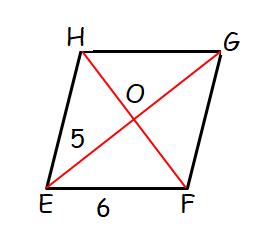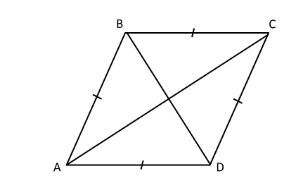PROBLEMS ON PROPERTIES OF RHOMBUS
Subscribe to our ▶️ YouTube channel 🔴 for the latest videos, updates, and tips.
- All sides of rhombus are equal.
- The opposite sides of a rhombus are parallel.
- Opposite angles of a rhombus are equal.
- In a rhombus, diagonals bisect each other at right angles.
- Diagonals bisect the angles of a rhombus.
- The sum of two adjacent angles is equal to 180 degrees.
- The two diagonals of a rhombus form four right angled triangles which are congruent to each other.
Problem 1 :
Three vertices of a rhombus taken in order are
(2, −1), (3, 4) and (−2, 3)
find the fourth vertex.
Solution :
Let the given points be A (2, −1), B (3, 4) and C (−2, 3) and the required point be D (a, b).
Midpoint of diagonal AC = Midpoint of diagonal BD
Midpoint of diagonal AC = (x1 + x2)/2, (y1 + y2)/2
Midpoint of diagonal AC = (2 - 2)/2, (-1 + 3)/2
= (0, 1) ----(1)
Midpoint of diagonal BD = (3 + a)/2, (4 + b)/2 ----(2)
(1) = (2)
(3 + a)/2, (4 + b)/2 = (0, 1)
|
Equating x coordinate (3 + a)/2 = 0 3 + a = 0 a = -3 |
Equating y coordinate (4 + b)/2 = 1 4 + b = 2 b = -2 |
So, the required vertex is (-3, -2).
Problem 2 :
Assume quadrilateral EFGH is a rhombus. If the perimeter of EFGH is 24 and the length of diagonal EG = 10, what is the length of diagonal FH?
Solution :
Perimeter of rhombus = 24
4a = 24
a = 6
Side length of rhombus is 6
Length of diagonal = 10
In rhombus, we have four right triangles.

In triangle OEF
OE = 5
Half length of diagonal FH = x
102 = 52 + x2
100 - 25 = x2
x2 = 75
x = 5√3
Problem 3 :
If the area of a rhombus is 112 cm2 and one of its diagonal is 14 cm find its other.
Solution :
Area of rhombus = (d1 ⋅ d2)/2
d1 = 14 cm, d2 = ?
Area = 112 cm2
(14 ⋅ d2)/2 = 112
d2 = 112(2)/14
d2 = 16
So, the other diagonal is 16 cm.
Problem 4 :
The length of diagonal are ratio 5:4 area of rhombus is 2250 cm2 find the length of diagonals.
Solution :
Length of diagonals are 5x and 4x.
Area of rhombus = 2250 cm2
(5x ⋅ 4x)/2 = 2250
20x2 = 4500
x2 = 225
x = 15 cm
5x = 5(15) ==> 75
4x = 4(15) ==> 60
Length of diagonals are 75 cm and 60 cm.
Problem 5 :
If opposite angles of a rhombus are (2x)° and (3x-40)° then value of x is ?
Solution :
In a rhombus, opposite angles will be equal.
2x = 3x-40
x = 40
Problem 6 :
ABCD is a rhombus in which AB is 3x-2, AC is 4x+4 and BD is 2x. Find x.

Solution :
AB = AD = 3x-2
AC/2 = (4x + 4)/2 ==> 2x + 2
BD/2 = 2x/2 ==> 2
(3x - 2)2 = (2x + 2)2 + x2
9x2 + 4 - 12x = 4x2 + 8x + 4 + x2
4x2 - 12x - 8x + 4 - 4 = 0
4x2 - 20x = 0
4x(x - 5) = 0
x can not be 0.
So, x = 5.
Subscribe to our ▶️ YouTube channel 🔴 for the latest videos, updates, and tips.
Kindly mail your feedback to v4formath@gmail.com
We always appreciate your feedback.
About Us | Contact Us | Privacy Policy
©All rights reserved. onlinemath4all.com

Recent Articles
-
10 Hard SAT Math Questions (Part - 45)
Jan 19, 26 06:14 AM
10 Hard SAT Math Questions (Part - 45) -
10 Hard SAT Math Questions (Part - 44)
Jan 12, 26 06:35 AM
10 Hard SAT Math Questions (Part - 44) -
US Common Core K-12 Curricum Algebra Solving Simple Equations
Jan 07, 26 01:53 PM
US Common Core K-12 Curricum Algebra Solving Simple Equations
